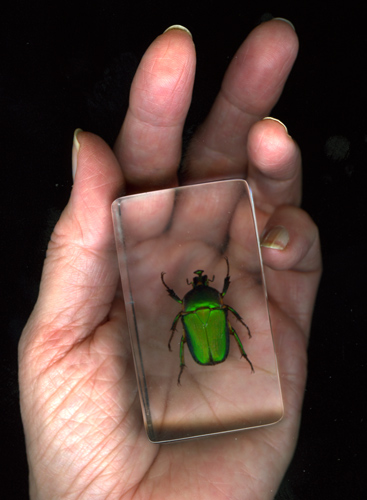chafer beetle


After scanning a moth and a fly, along with a comment about scarabs, I remembered another insect, a chafer beetle perfectly preserved in resin, a paperweight I think. it was given to me as a gift many years ago. Of course I had to scan this too. I started with just the object but the resin has scratches and imperfections so finally I went back to my technique of ‘hand with object’ with much better success. Beautiful beetle, isn’t it?
Besides thoughts of ancient Egyptian scarabs, which are actually dung beetles, I’m reminded that the Greater Vancouver area has a serious chafer beetle infestation destroying many lawns, including ours. I think our beetle is the brown European one rather than this gorgeous green. The grubs root under the turf, then raccoons, skunks and some birds dig up the patches in search of tasty meals. I must remember to buy and apply some nematodes on it this summer (I forgot at the recommended time last year).
So that’s the story of a beauty and a beast!
March 24, 2013 in Human, Nature, Photoworks by Marja-Leena
It really is a beauty and a perfect compliment to the other two recently scanned insects. Aren’t you glad I didn’t suggest you hold the fly?
I recently saw pictures of another really pretty insect – the Golden Tortoise Beetle.
When I attempted to grow roses in Portland (east facing balcony didn’t work), I well remember the Japanese beetles that came to dine.
When I lived in Western Japan, a department store had a living beetle exhibit. I went despite my misgivings. And I am happy to report that watching the joy on the faces of the children there helped me to appreciate a beautiful pet beetle!
Susan, yes, it would have been difficult to hold that tiny fly and I don’t think anyione would like to see my wrinkles magnified 500%.
That Golden Beetle is amazing, like precious gold jewelry to rival the scarabs. Isn’t the insect world amazing?
As for Japanese beetles, I was going to say I’ve had them in my garden sometimes but according this article BC, Oregon and other western states are free of it. Hmm.
Rouchswalwe, children do seem to have a great fascination for beetles and bugs, don’t they?
You’re right. My balcony roses were definitely afflicted by aphids and some sort of blight but now I’m not sure what kind those beetles were. The fuchsia plants were much happier.
Susan, I too would like to know what it was. In this age of the internet we can search and learn so quickly yet the insect world is vast.
Like the way the little striations on your hand at left seem to echo the beetle’s compartmentalized body. Oddly, this seems the only one where the hand has that look, and it’s such a fit.
I think you like jewels! All this gold and gemwork!
Marly, you are very observant! I had not thought of that ‘echo’ but did feel a bit of concern about all those wrinkles 🙂 Of course I like jewels, especially unusual ones.
A shade of green to treasure.
Joe, yes, indeed, and more beautiful than the common brown one infesting our lawns.
Wrinkles are fine to me! I like the way your hands look–an artist’s hands, made for use, graceful in gestures. They become like evidence of character if not polished and painted and air-brushed out of existence… And I think that is lovely.
Marly, thanks, you are so kind. Even if I polished and painted, and I don’t, I think natural hands suit the nature based objects in this hands series.
This make me think again of the “Eyes as Big as Plates” project which we both recently blogged about, of very natural wrinkled elders dressed in elements from nature — they would not look the same if fashion models had been used.
Yes, I agree. Still wish they’d used only natural materials in the clothes, but I love them…
Marly, yes, natural materials in the clothing would have been better though I imagine the artists’ budgets would not have covered that. Draping a sheet of burlap might look too faked. Then again, maybe there’s a statement there about the ancient world and our “modern?” world of industrial materials.